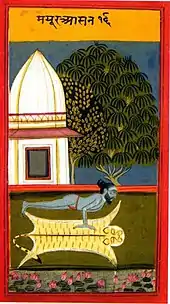Kapalabhati
Kapalbhati (Sanskrit: कपालभाति, romanized: kapālabhāti, "Skull-polishing") is an important shatkarma, a purification in hatha yoga. The word kapalabhati is made up of two Sanskrit words: kapāla meaning "skull", and bhāti meaning "shining, illuminating". It is intended mainly for cleaning the sinuses but according to the Gheranda Samhita has magical curative effects.[1] There are three forms of Kapalabhati:
- Vatakrama, a practice similar to the pranayama technique of Bhastrika or "Breath of Fire", except that exhalation is active while inhalation is passive, the opposite of normal breathing.
- Vyutkrama, a practice similar to Jala neti, it involves sniffing water through the nostrils and letting it flow down into the mouth, and then spitting it out.
- Sheetkrama, essentially the reverse of Vyutkrama, in which water is taken through the mouth and expelled through the nose.

References
- Kapalbhati - Frontal Brain Purification, in Yoga Magazine, a publication of Bihar School of Yoga.
https://www.vinyasayogaashram.com/blog/kapalbhati-pranayama-benefits-how-to-do-it-and-precautions/
This article is issued from Wikipedia. The text is licensed under Creative Commons - Attribution - Sharealike. Additional terms may apply for the media files.
